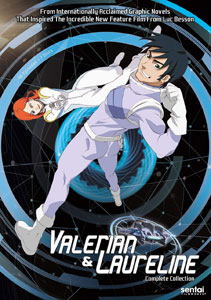The “Valerian and Laureline” franchise follows a similar pattern to the “Teenage Mutant Ninja Turtles” empire. Both started with a comic aimed at adults (or at least young adults), were franchised into a cartoon aimed at kids, and then a movie aimed somewhere in between. In each case, those in charge rejiggered the characters, vehicles, settings, plot and purpose.
Different, but still appealing
In the French-Japanese production “Time Jam: Valerian & Laureline” (2007-08) (of which I’ll look at the first 10 of the 40 episodes here), I expected “VINO” – “Valerian in Name Only” – perhaps something with a heavy Japanese anime influence. To some degree that’s accurate, but only to the same degree that the “TMNT” cartoon is distanced from the “TMNT” comic. They are clearly different, but can appeal to the same audience.
About those differences, though. What makes Pierre Christin and Jean-Claude Mezieres’ comics special is that Valerian and Laureline meet, generally like each other in their early adventures, and are soon openly in love. It just happens, without any miscommunication-laden romantic arc. They don’t even get married; they are just “Valerian and Laureline,” a team in every way, no more need be said about it.

“Time Jam: Valerian & Laureline” (2007-08)
40 episodes, Crunchyroll
Creators: Stéphanie Joalland, Marc Journeux
The cartoon maintains the fact of their love, but chooses the traditional “bickering to hide their feelings” structure. The voice actors’ work is decent, although sometimes their lines are rushed at the expense of the tone, as they are dubbing English over the original French.
I wonder if French-accented English would’ve made V&L seem more like their lovebird comic counterparts than British-accented English, if only because the stereotypes would line up better.
A more deliberately portrayed love
The stories make it clear that the two love each other, but it comes through raw data points rather than glances held a moment too long, hitches in their voices, that sort of thing. In “Doing Time” (episode 6; every episode has the word “time” in it), Valerian thinks of Laureline while the villain of the week scans his brain for an android body.
Later, he tells Laureline that he could’ve been thinking of anything. While the dialog tells the viewer what’s up, “Time Jam” never shows any directorial style in wordless moments; true, that’s harder to do in animation than in live-action, but far from impossible.
As for Laureline: In the comics and movie, she is a spatio-temporal agent like Valerian, and they are assigned as partners. The cartoon, though, blends an early and late element of the comic arc for a new plot: In the pilot episode, “Time Matters,” Valerian rescues Laureline from 10th century France, where she is in trouble for rejecting the advances of a warlord.
Interestingly, Valerian – who had been drilled by his bosses to not do anything to change timelines – takes his training seriously and doesn’t want her to come along. But she does, playing the card that she had saved his life and he owes her (this mirrors the first comic story, “Bad Dreams”). When they return to the future, Earth is gone; this will be the overarching story for the whole animated saga; it’s even in the theme song lyrics: “… he’s always looking for planet Earth …”

Valerian doesn’t hold the absence of Earth against Laureline, but he chastises her for spending 7K blutoks of a 10K payout on clothes (frankly, he has a point there). This is a departure from the comics’ Laureline, the more responsible of the pair (although she does like fashion). On the other hand, in “Any Time” (9), a madness bird (a nod to “Birds of the Master”) bites Valerian, causing him to go insane, and Laureline saves him.
It’s not Laureline’s job
Here’s the biggest thing to note about Laureline’s point of view: Unlike in the comics and movie, it’s not her job to stay with Valerian. She could strike out on her own, but chooses to stay. By the same token, Valerian never asks her to leave. In part this could be because of the bond of being the only two humans in the galaxy, but still, it’s not all that alien of a galaxy: There are many humanoids, and everyone speaks English.
By the nature of anime, “Time Jam’s” action scenes are showy as opposed to the matter-of-fact approach of the comic. Valerian is a big action hero, swinging into battle from energy ropes; Laureline does incredible gymnastics, with anime-style grunts of exertion. In these “cool” action scenes, the other definition of “cool” is sacrificed.
The TV show’s creators borrow several elements from the comic. Valerian’s ship gets a name, the Tempus Fugit, and is redefined as being the very first time-travel ship. To more efficiently illustrate suspenseful moments, the ship gets an on-board voice named Rhonda (Besson would use “Alex” in the movie). But when the Tempus Fugit is damaged in “Time Share” (8), V&L get a new, sleeker ship (and Rhonda moves over with it).
Providing an anchor point to the “Valerian” of it all, the Shingouz trio pops up fairly regularly as the brokers of our heroes’ delivery assignments. More than once, that assignment is to deliver animals to some unsavory character, and those episodes call to mind “The Living Weapons” and “Welcome to Alflolol.” The lovable Goumon from the latter – essentially a large dog – is repurposed for “Any Time” along with that madness bird.
In the closing credits, I see a quick image of Ralph the Glapium’tian, so I look forward to his appearance later on. And is it too much to hope for a Grumpy Transmuter from Bluxte? If not, at least he’s the breakout star of the movie. To the show’s credit, it maintains the comics’ spirit of adventure and the bevy of crazy creatures our heroes meet along the way — although, inevitably since this is animation instead of static panels, this world feels a bit less populated.
Socio-politics jetisonned
As you’d expect from the fact that this is a kids’ show, 95 percent of the socio-political commentary, parody and satire from the comics is dumped. “Modern Times” (3) is the closest the TV show comes so far, as immigrants aim to colonize a planet so it’ll have enough population to have voting rights in the galactic government.
Gork Yodol, the Big Bad snouted alien who aims to rule the galaxy, wants to stop the colonization. So far, Yodol is a dull villain: In addition to being an utter cliché, he is rendered as a computer model (while most of the show is hand drawn), and it’s a little distracting.
While these first 10 episodes aren’t quite the “Valerian and Laureline” I know from the comics, I’m mildly intrigued and keeping an open mind. I’m hoping the pair’s relationship will get warmer and the sitcom bickering will be lessened. I’m looking forward to seeing Ralph and other comic-book references. I feel confident that the series will get better as it goes forward.
“Time Jam” is available for free on crunchyroll.com with commercials, and can also be purchased on DVD.
More “Time Jam” reviews:
Click here for a complete index of “Valerian and Laureline” reviews.

